
bringing nature, nurseries and gardeners together Oct. 30, 2020
|
|
News from Rockport: Diane and Chris Winslow, owners of It's About Thyme Nursery, are back in business... sort of. On Saturday mornings they can be found at the Rockport Farmers Market at the town's festival grounds selling a wonderful variety of plants and veggies. Says Chris: "Having a blast! But missing all of my It's About Thyme friends."❦
_________________________________________________
Ultimate Twilight: the Wildflower Center invites all to gather in Halloween costumes tomorrow evening (Oct 31) to enjoy the new Fortlandia and the beautiful gardens at the bewitching hours of 5 - 7 p.m. "But keep those mummy mouths (and noses) under wraps," say the organizers. (Reserve tickets ahead of time.) Wildflower Center ❦

Black Lives Veggies: please consider helping to support this exciting new venture. Gardeners Johnny Jefferson, Jonathan Horstmann and Larry Franklin have created their own garden vegetable company and are in need of donations and customers. "We believe that how we nurture the seed from start to finish has the capability to heal the world." Facebook Austin Chronicle ❦

Tobacco to the rescue. With a new lease on life helping to produce a key protein that can be used in a vaccine against COVID-19, Nicotiana benthamiana is poised to move from pariah... to savior. A tobacco excutive admits: "There's an obvious irony there." NPR ❦

Mums and cabbages. Writes artist Linda Anderson: "The garden blog I read says to put flowers in with your veggies to confuse the bugs." Gardening Know-How ❦
Help Turn Hancock Golf Course into a greenspace: after 122 years of golf, it's time to open the gates for all to enjoy this beautiful crown jewel of a park in central Austin. Please consider signing this petition. Hancock Conservancy Poll.
(Disclosure: the newsletter editor is a member of the Conservancy and a passionate advocate for change ; - ) ❦

Central Texas Gardener: Need evergreen ideas for sun, deep shade, and in-between? Jessica Robertson from wholesale Greenleaf Nursery Company texturizes with easy care plants for structure, screening, and groundcover. Trisha Shirey and Tennessee gardener Barbara Wise explore hardy plants for shady gardens. KLRU ❦
 Miracle at Smith Elementary
In Central Texas, an abundance of squash is not a joke — it’s a miracle.
by Renee Studebaker
I planted squash seeds in March —Tatume, Costata Romanesco, Waltham Butternut and Seminole — and now, more than six months later, I’m still harvesting squash.
If you look at the photo above, which I took a little over a week ago, and imagine that I was harvesting that much every week and sometimes twice a week for about four months, you’ll get a pretty good idea of how much squash I’m talking about. A LOT OF SQUASH.
Given the fact that the Smith Elementary School garden (where all this squash was grown), has a healthy population of squash vine borers, how is this even possible?
I don’t know, but I’m not complaining. Too much squash has never been a problem in my world. Which brings me to something I don’t understand: Why are there so many jokes about funny things home gardeners do to get rid of surplus zucchini?
Not once in my many years of home gardening have I considered sneaking onto a neighbor’s porch to deposit a bag of squash. And I’ve definitely never considered leaving a pile of squash in the back seat of an unlocked parked car. And have you heard the one about placing an overgrown zucchini in your toilet tank to save water?
Maybe joking or not joking about zucchini depends on the presence, or absence, of the infamous squash vine borer. If you’re gardening in a part of the country that has large populations of borers (pretty much every state east of Interstate 35), you don’t worry about runaway squash plants. In fact, depending on the varieties you’re growing, you may not get any squash.
If you’re in the western half of the country, where, apparently, squash vine borer moths (Melittia cucurbitae) are not lying in wait for your squash seeds to sprout, you could be overwhelmed by nonstop squash production all summer long. OK, so I can see how that might be a little bit funny, but if you’ve got too much squash, why not just donate it to a food pantry?
Perhaps I’m not the right audience for zucchini jokes. I certainly didn’t have any trouble finding good homes for all the extra cucurbits coming out of the Smith garden. Over the summer, custodians and other staff working at the school were happy to take home a few squash. And friends who came to the Smith garden to help pull weeds never said no to a bag of squash offered as a thank-you for their help.
And then there are my garden students. This week, I resumed teaching after-school classes in the garden at Smith (only a handful of students with everyone wearing a mask), so now I’ll be able to send squash home with each one of my students, some of whom helped collect and save the seeds last year for the open-pollinated squash we’re growing this year.
The commonly accepted borer remedies — slicing open the stems to remove the larva, spraying the leaves and stems weekly with BT, picking off the tiny brown eggs, and growing the plants under row cover— seemed like too much to deal with in school garden classes, so at Smith, we have focused our growing efforts on SVB resistant Tatumes, Seminoles and Butternuts, which can all withstand some borer damage and keep on producing. We’ve also had pretty good luck with Costata Romanesco, a sturdy, thick-stemmed heirloom zucchini.
(To my taste buds, these varieties are every bit as good as the more common straight neck yellow squash and dark green zucchini, which seem to have no defenses against the borer.)
At planting time, we always sow extra seeds because I assume the SVB’s will take out at least half the plants. We also give the plants plenty of space so the vines can roam and put down new roots, which helps them out-run the borer damage. When the summer heat comes on, I top dress the plants with plenty of compost and make sure they get regular water.
Apparently, these steps can sometimes pay off with a big squash harvest. And in my garden book, that is not a laughing matter. ❦
Longtime Austin gardener and writer Renee Studebaker is a retired newspaper journalist who now teaches children how to grow and cook vegetables. (Renee also took the photo.)
|
 It's About Thyme Legacy Publications.
Contact newsletter editor Darrel Mayers with any ideas for articles or interesting links at internationalrain@yahoo.com (hitting 'reply' to this email won't work) |
|
|
